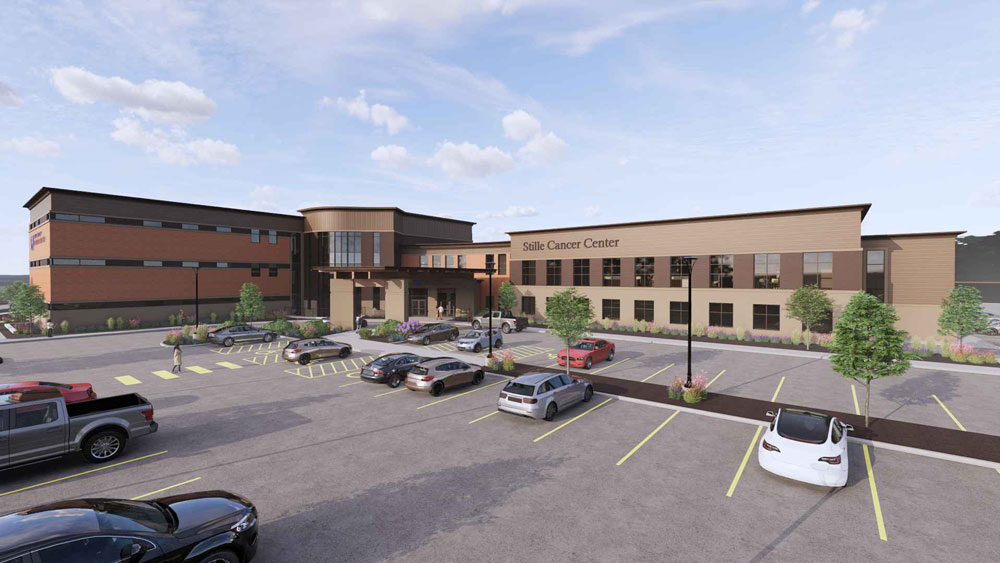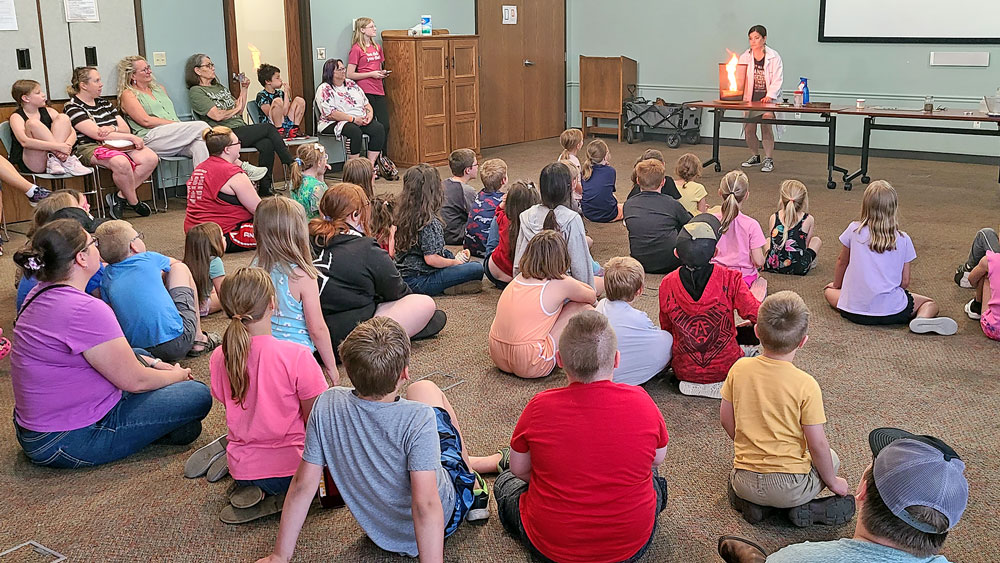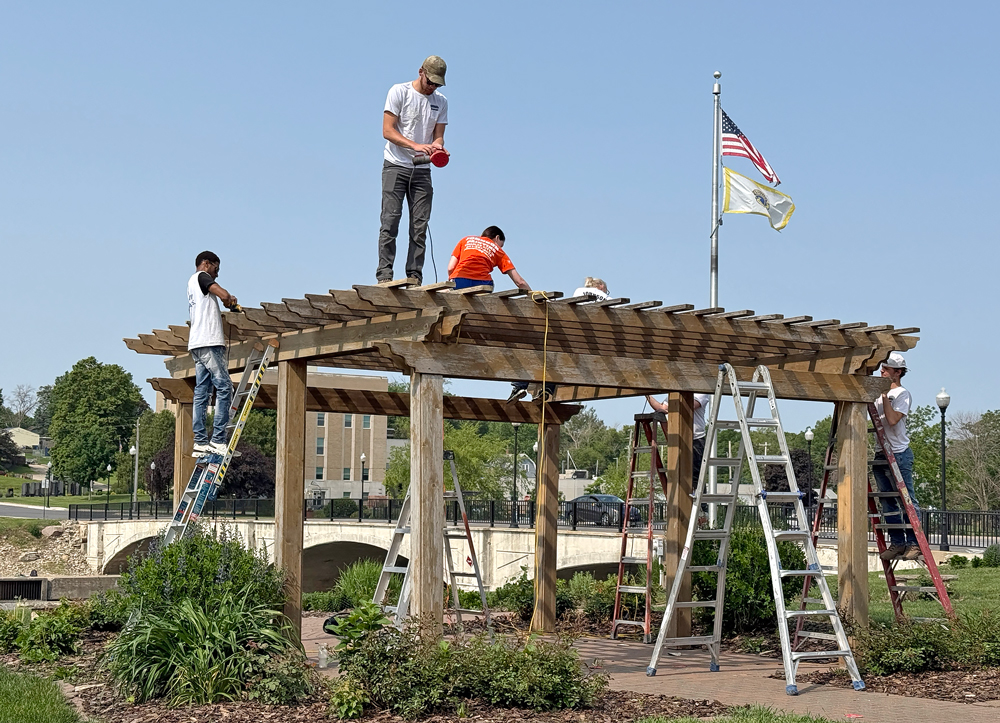Second reading for proposed new Floyd County wind energy ordinance is Tuesday evening

Press photo by Bob Steenson
By Bob Steenson, bsteenson@charlescitypress.com
The Floyd County Board of Supervisors will hold the second reading tonight (Tuesday, Sept. 3) of a proposed zoning ordinance that would set regulations and specifications for commercial wind projects in the county, as well as commercial battery storage rules.
The meeting will begin at 6:30 p.m. in the Emergency Operations Center (EOC) in the ground floor atrium between the county courthouse and the Law Enforcement Center.
Included in the packet for tonight’s meeting is a lot of supplementary material, including comments and information from the consultant that the county has helping with the process, comments from the county attorney regarding amendments made at the first reading almost a month ago, and comments regarding those amendments from one potential wind energy company.
Representatives of companies interested in building new commercial wind energy projects in the county have said that if the supervisors retain the amendments that were added during the first reading, on Aug. 6, it will effectively kill any future wind energy projects in Floyd County.
The most limiting of those amendments would allow a total of 70 commercial wind turbines in the county – only 20 more than the 50 turbines in the already existing MidAmerican Charles City Wind Farm.
“As written, these measures amount to a prohibition on a modern wind project,” wrote Isaac Lamppa, project manager for a proposed Invenergy wind project in Floyd County
“First, the height limitation would take out of consideration most commercially available turbines. A reasonable height limit would be 600 feet. Second, the turbine cap is far too low and effectively says ‘no’ to both wind projects that the county is aware of being developed in the county,” Lamppa wrote.
Several of the amendments offered by Supervisors Jim Jorgensen and Dennis Kiefer at the first reading raised questions that were referred to the county attorney. County Attorney Todd Prichard’s responses are included in the agenda packet for tonight’s meeting.
Regarding the amendment limiting the height of turbines to 450 feet and limiting the total county number to 70, Prichard wondered at the number 70.
That amendment had been offered by Jorgensen and approved by a 2-1 vote, with Supervisor Chair Mark Kuhn voting against, as was the case with almost all of the amendments that were approved.
“A plaintiff may say that 70 is an arbitrary number,” Prichard wrote. “Is there some rational basis for the number ‘70’? In other words why 70?”
An amendment offered by Kiefer to prohibit wind turbines from being installed on “highly productive soils where the parcel is rated at an average of 79.5 CSR2 or above” was not voted on at the last meeting after Floyd County Zoning Administrator Jessy Willadsen wondered whether it would be considered a government “taking” of property.
Prichard wrote in his comments, “I would argue that this is an improper regulation as it regulates land without a legitimate government purpose. I would advise not to pass this amendment as it may be unconstitutional.”
Another amendment would set the maximum sound level from turbines when measured at the nearest occupied structure at 40 decibels.
Prichard said he had “no real issue” with setting a limit, but added, “I would recommend that 40 not be arbitrary. In other words why 40 (dBA)?”
The proposed ordinance had been developed by the Floyd County Planning and Zoning Commission with the help of North Iowa Area Council of Governments (NIACOG) Senior Planner John Robbins, and had been recommended to the Board of Supervisors after months of joint meetings between the supervisors and P&Z, public input sessions, hearings and workshops.
The proposal also includes rules for commercial battery energy storage, but that part has received far less attention from the public than the wind turbines. Eventually Robbins is also supposed to help develop regulations for commercial solar power projects.
The commercial wind energy proposal that had been developed and recommended by Planning and Zoning is a much more detailed version of an ordinance that had been on the county books for years, but it would keep the same process for approving a commercial wind project – seeking a conditional use permit through the Floyd County Board of Adjustment.
One of the first amendments that had been offered at the previous meeting, by Kiefer, was to switch the decision-making power from the Board of Adjustment to the supervisors.
Prichard commented that if the supervisors want to make the decisions the ordinance would have to be rewritten because the supervisors cannot approve a conditional use permit. Approvals would have to be through zoning.
“I recommend board of adjustment,” Prichard wrote.
Robbins, the NIACOG planner, wrote a lengthy discussion regarding the differences between approval by conditional use permit or approval by zoning overlay, and said either could be used, but changing to zoning would require rewriting the proposed ordinance.
“The reason the Zoning Board of Adjustment (ZBA) is traditionally used for Conditional Uses is an attempt to remove the political side from the process a bit and the body operates as a ‘quasi-judicial’ body (somewhere between a town hall and a court),” Robbins wrote. The Board of Adjustment has oversight by the Board of Supervisors.
The “con” side of that argument is the Board of Adjustment is not an elected board subject to direct voter oversight, Robbins wrote.
Another “pro” argument for keeping it with the Board of Adjustment is that body can attach additional requirements that a permit applicant must meet.
“This is a powerful tool,” Robbins wrote. “This process has a lot more flexibility for specific situations that may arise with a specific proposal.”
Attention to wind energy began receiving new interest more than a year ago, when it became widely known throughout the county that at least two companies had begun meeting with rural landowners about potential easements for the location of wind energy turbines.
The two companies are Invenergy and NextEra Energy Resources.
Invenergy’s “Marble Ridge Wind Energy Center” project is described by the company as:
- 30 to 50 turbines.
- 180 megawatts total capacity.
- $100 million in payments to landowners over 40 years.
- $70 million in property taxes over 40 years.
- 300 short-term construction jobs.
- Up to 8 full-time operations and maintenance staff.
- About 3,300 acres initially part of project, with about ½ acre used per turbine once the project is in operation.
NextEra Energy Resources describes its “Rudd Wind Project” as:
- 300 megawatts total capacity.
- About 100 turbines.
- Five-year development timeline.
- Construction phase in 2028.
- 30-50-year lifespan.
- About 100 acres used for operations.
NextEra has not provided estimated total landowner easement payments or property tax payments, but it would be about twice the size of the Invenergy project.
At the end of tonight’s meeting the supervisors are likely to vote on the second reading of the ordinance, including any amendments that might be passed tonight, unless they call for major revisions such as changing the method of approving projects from the Board of Adjustment to the Board of Supervisors.
If a second reading is passed, the supervisors will likely schedule a third and final reading. Whatever version of the ordinance is passed at that reading would become law in the county.









Social Share